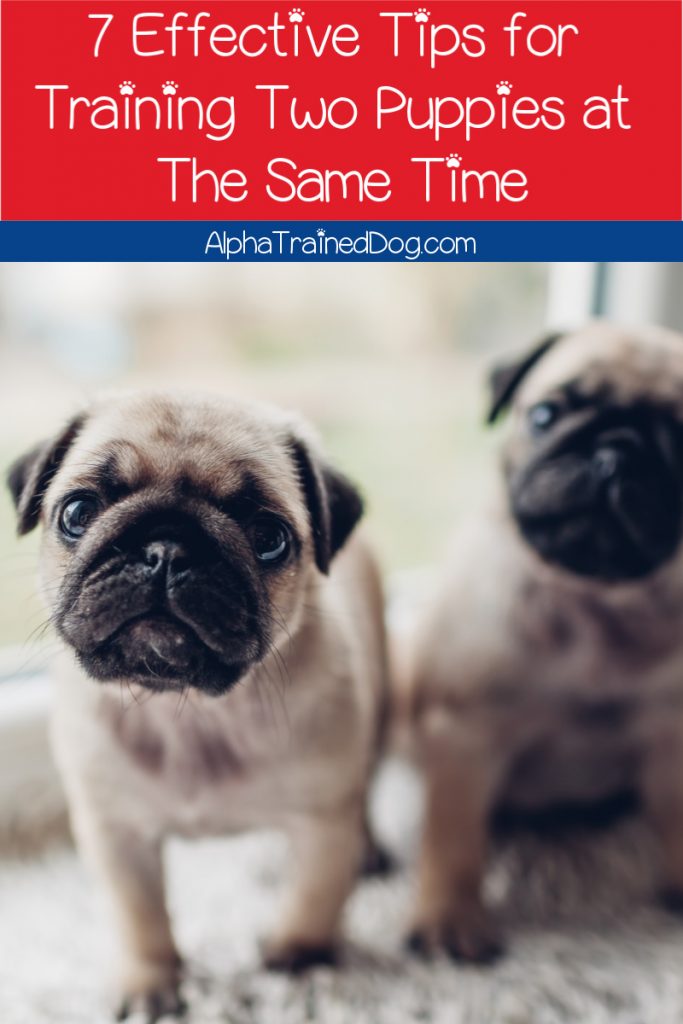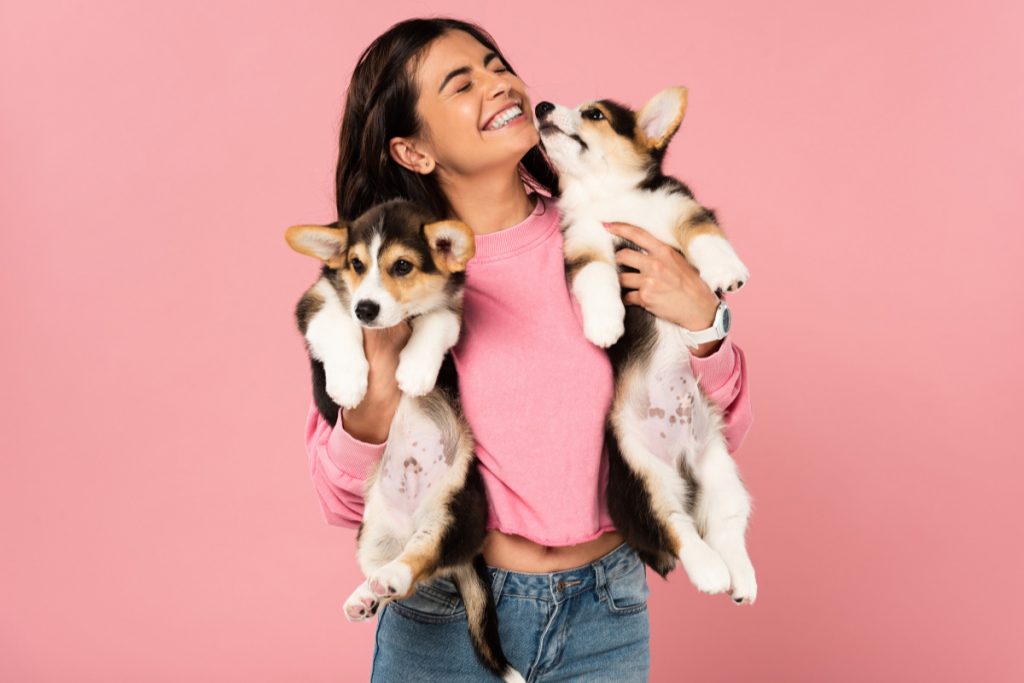Can you imagine training two puppies at once?
Training a single puppy is a serious challenge, so you’re right to worry about how you’d manage two.
But I’ve got 7 simple puppy training secrets to help you achieve your goal.
Just keep on reading.

7 Training Tips For Training Two Puppies at Once
Most specialists don’t recommend getting two puppies at once, even if they’re from the same litter.
Leaving the financial aspect aside, many argue that two puppies might bond closely to each other instead of their human.
They’re also likely to get anxious or stressed if separated.
However, sometimes you end up with a pair of puppies.
Then you have to train them in such a way so that both puppies reach their full potential.
#1 Make Proper Introductions
When you take two puppies, they might not be from the same litter.
Then your first step would be to introduce the puppies to one another.
That’s not such a hard task because puppies are open to new experiences and accept new play buddies quite eagerly.
Most specialists agree that it’s better to bring one of the puppies home and let the little one adjust to your home for a few days.
Then you can introduce the other one and let the puppies get to know each other.
That makes sense because two scared puppies who miss their mother and siblings might be too much to handle.
#2 Train Your Puppies Individually
People often say that it’s easier to train two dogs than one. However, they’re talking about an adult dog and a puppy.
That’s because the adult dog shows the ropes to the young one. When you’re training two puppies, this principle doesn’t apply.
Puppies are like children, meaning that they learn at their own pace.
Even puppies from the same litter have different temperaments and learning abilities.
You might want your two puppies to master commands with the same skills, but it’s not going to happen.
One puppy might need five repetitions, while the other 50.
You might try it, but you’ll find that it’s challenging to keep both puppies occupied and focused on the same lesson.
As such, it’s for the best to train your two puppies individually.
Leave one of the puppies with a family member and work with the other. It will allow you to concentrate on each puppy and learn their strong and weak sides.
You might also enroll your puppies in different puppy training classes so that they can learn proper manners from other dogs.
#3 Begin Housetraining Immediately
Potty training two puppies at once isn’t that different from potty training one.
However, you have to take several things into account to make things easy for you:
- Pick a location and stick to it so that you don’t confuse the puppies.
- Establish a feeding schedule. Puppies have to go after they eat, so you’ll want to feed your two puppies at the same time. Otherwise, you’ll have to make several trips to the potty stop.
- Take your puppies outside to do their business as frequently as possible. Small puppies don’t have a lot of bladder control, so you’ll have to go every 1-2 hours.
- Always reward and praise your puppies when they do their business successfully. Remember not to rush them.
- Keep an eye for signs that your puppies need the bathroom.
#4 Have Two Crates
Crate training is essential when you have two playful puppies running around the house.
You want them to have a safe place where they can retreat when your puppies feel overwhelmed or anxious.
Moreover, you need to confine your puppies when you can’t supervise them.
No matter how well you have puppy-proofed the house, puppies also find trouble where you least expect them to.
Of course, crate training also helps with potty training two puppies at once.
That’s because dogs are clean animals by nature and avoid soiling their sleeping places.
So, crating your two puppies will help you speed up the housetraining process.
It’s for the best if you have two training crates for several reasons.
While it makes sense that you don’t want your puppies to get lonely at night, they’re more likely to soil their crate if you put them together.
Instead of sleeping, they’re going to play and wrestle.
Moreover, you want to encourage your puppies to be independent and prevent dependency and overbonding.
It can’t happen if your puppies share a crate.
#5 Play with Your Puppies Separately

As l already mentioned, puppies rarely have the same temperament, interests, or needs.
Some are dominant and likely to try and hog all your attention and push the other timid puppy aside.
It’s also likely that your two puppies might end up fighting for your attention if they’re both dominant.
You don’t want to have to break dog fights, right?
The solution is to play with each puppy individually every day so that you can spend quality time with each one and have the opportunity to bond.
It will also boost your puppies’ confidence and make them more independent.
#6 Walk Your Puppies Separately
When you’re training two puppies, you should take them for a walk and leash train them one at the time.
For one, you want your puppies to feel that they have your undivided attention. It allows you to bond and establish trust.
If you walk your two puppies at the same time, one might get dependent on the presence of the other to feel safe.
That could turn into a problem in the future if you can’t always walk the two dogs together.
Most specialists also advise that you socialize your puppies individually.
That’s because your puppies might have different reactions to the same situation, and the socialization process should be as positive as possible to avoid future behavior problems.
#7 Treat Your Puppies Equally
While dogs don’t feel jealousy as we do, they know when they’re being neglected.
So, you have to make sure that you pay equal attention to both puppies.
Otherwise, one or the other will feel left out and won’t bond with you.
Moreover, it’s important to have separate sleeping places (besides the crates), feeding bowls, and toys.
That will ensure that your puppies won’t feel the need to guard their possessions and become territorial.
In addition to this, you have to set your rules and enforce them equally.
Don’t let one puppy get away with misbehaving because the other will also disregard your rules.
Don’t think that you’re cruel by keeping the puppies separated while training and walking.
What you’re doing is allowing them to grow in character so that they can become best friends as adults.
Moreover, you ensure that they will bond closely to you as well.



It doesn’t have to be easy at all, but with your advice it also becomes extremely useful and intriguing so you can save time and be able to have two well-trained dogs since puppies.
I never owned a dog but I’ve always wondered how to train puppies. This must be so exciting…
This is exactly what I needed, thank you! We’re about to get two new puppies and we’re really excited, but I am nervous about trying to train them both at once.
We have recently discussed getting a second bichon but our first little guy is pretty mischievous so I have had reservations. I guess if done correctly, two at the same time doesn’t have to be so bad huh?
Puppies are such amazing, loving animals and they are legit something else. I agree with all of these 7 tips! Just like human children if you’re going to have two puppies, you have to get to know them both separately, ensure that you treat them both lovingly and be aware of their individual needs. They are alot of work, but so worth it.
Wow, I can’t even imagine training TWO puppies at once. One is enough for me. But these tips are great and make it seem like it can be done. 🙂 Taking them on separate walks makes immediate sense.
These are such top tips! I love puppies but wouldn’t have a clue how to train one, let alone two!
These are great tips. My next door neighbour just got two puppies and I’ve been wondering how she’s managing them so well. Now I know! 🙂
Louise x